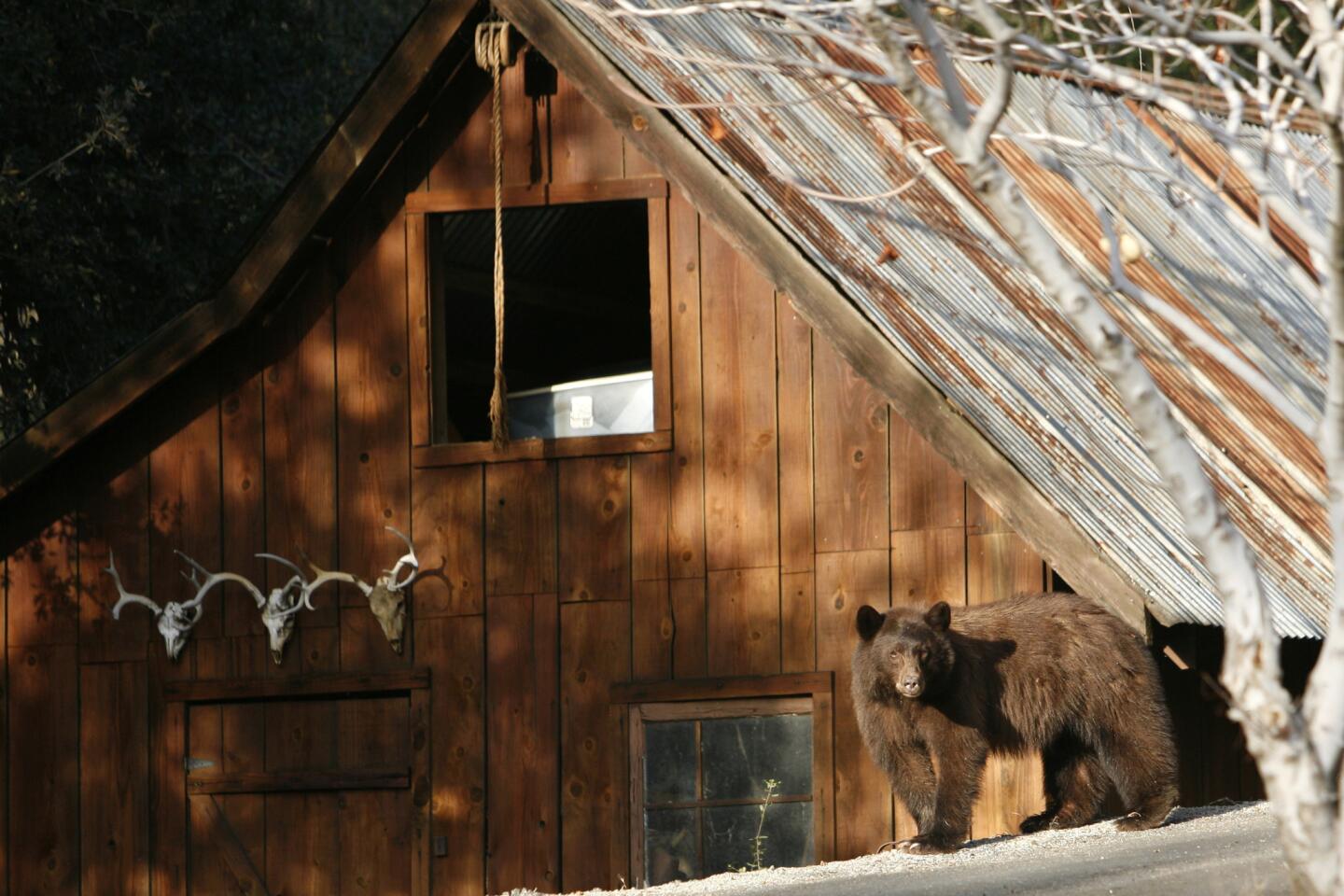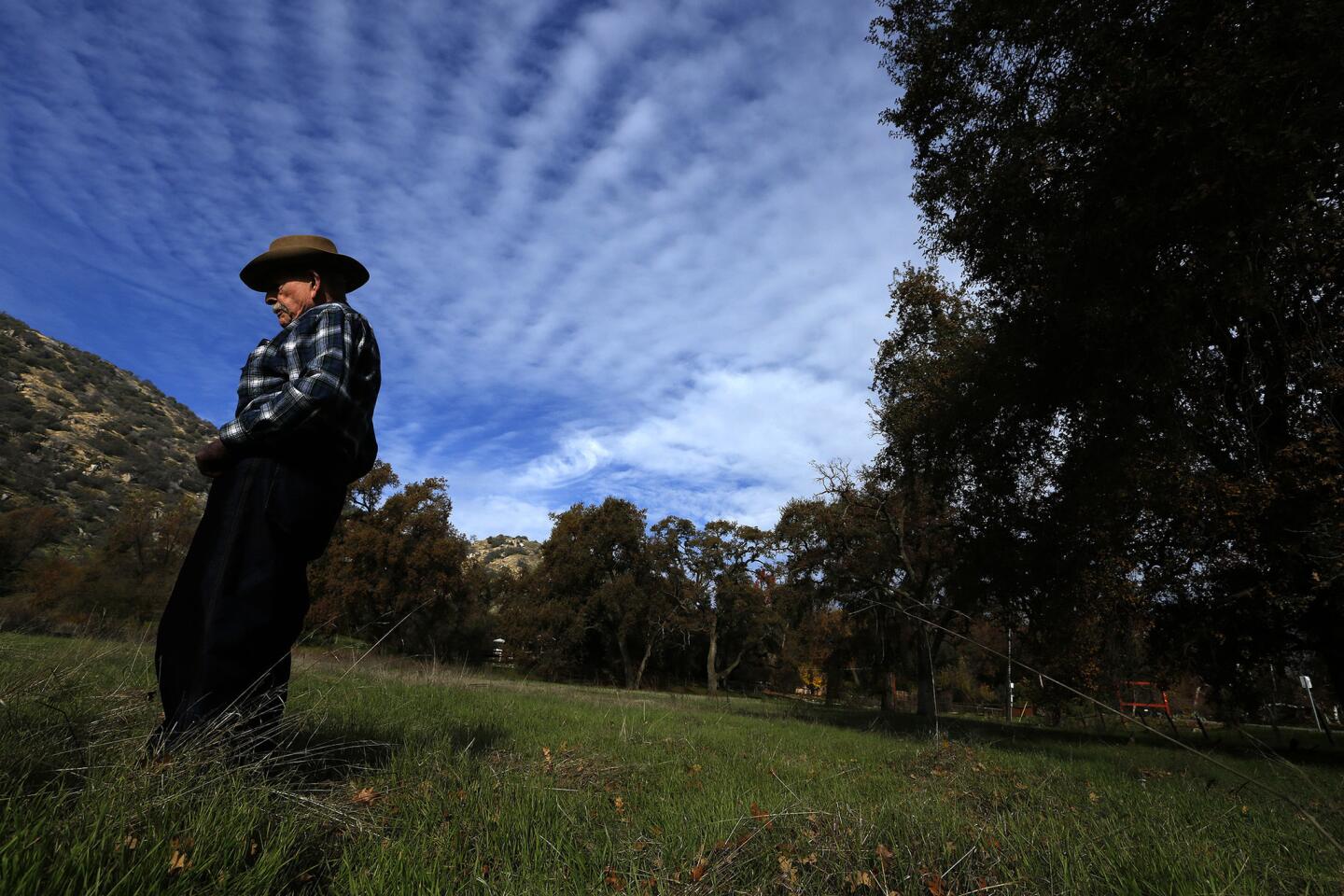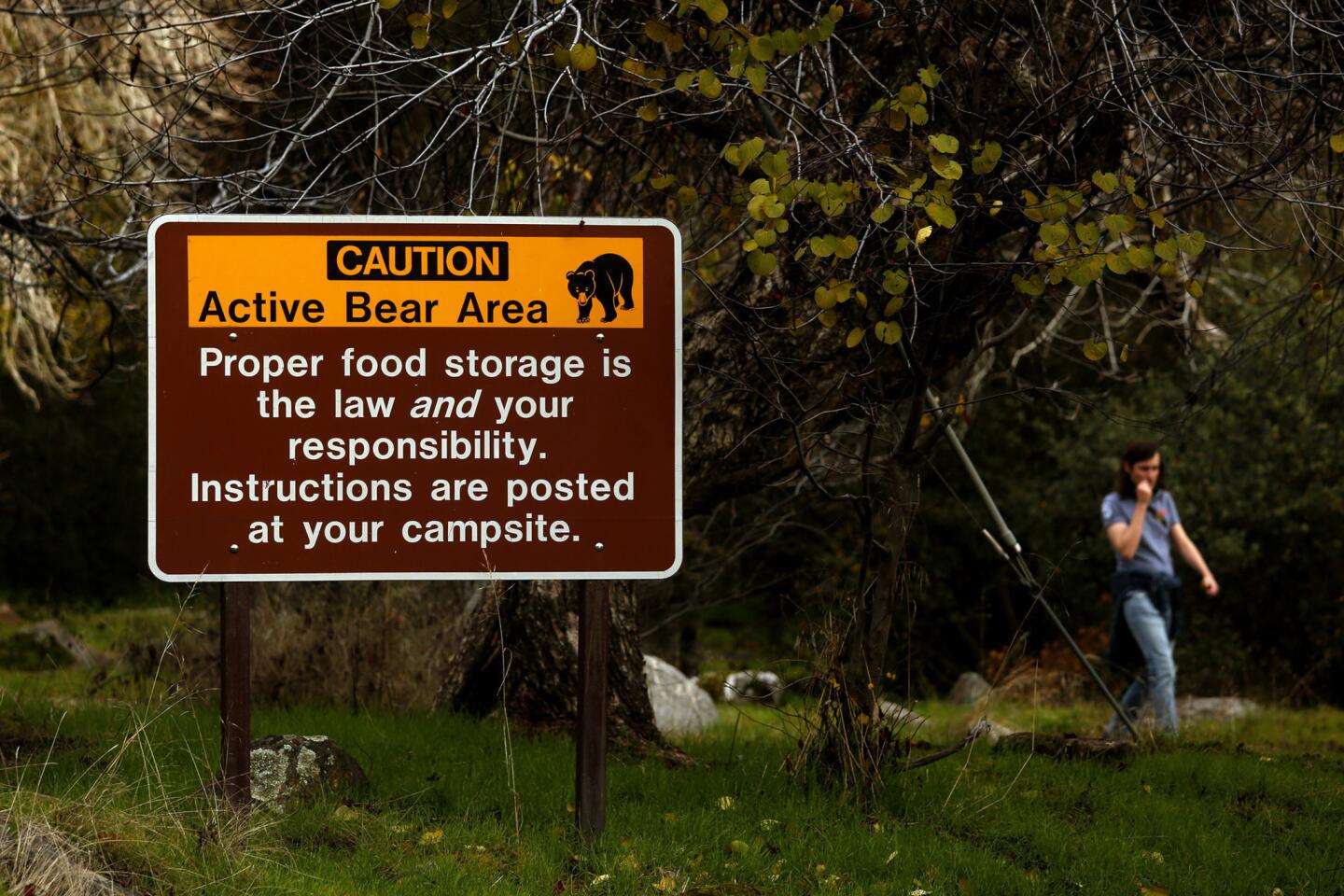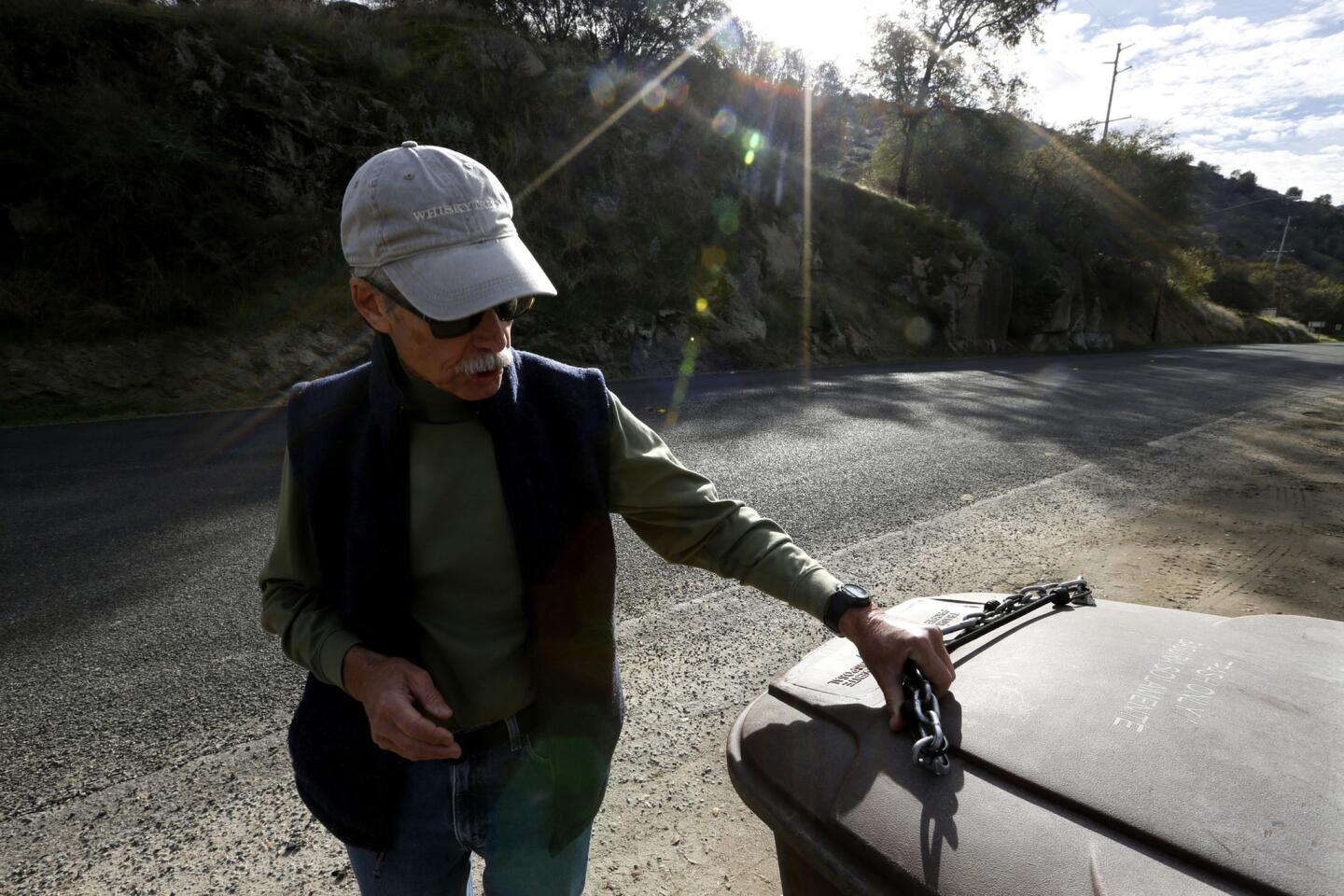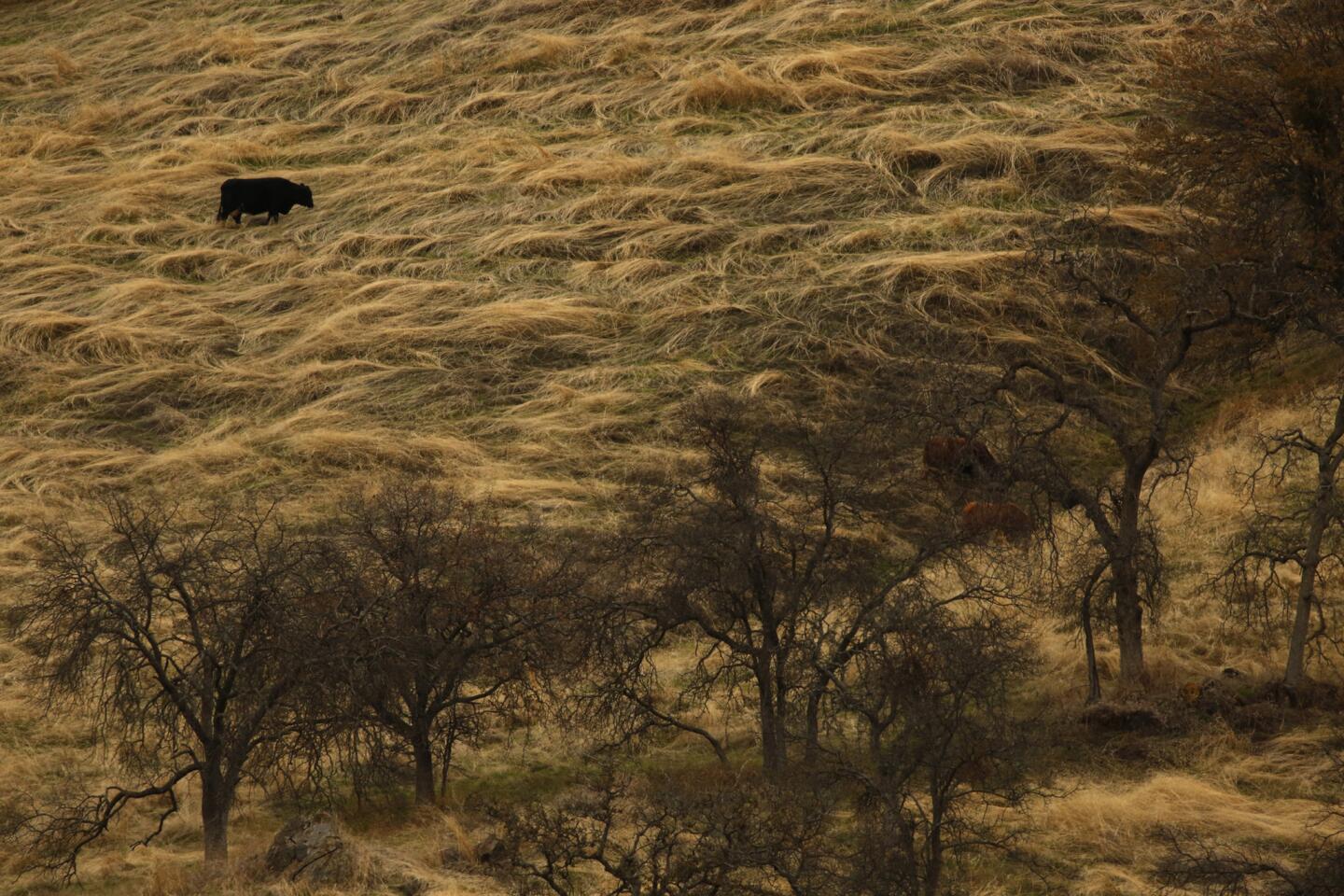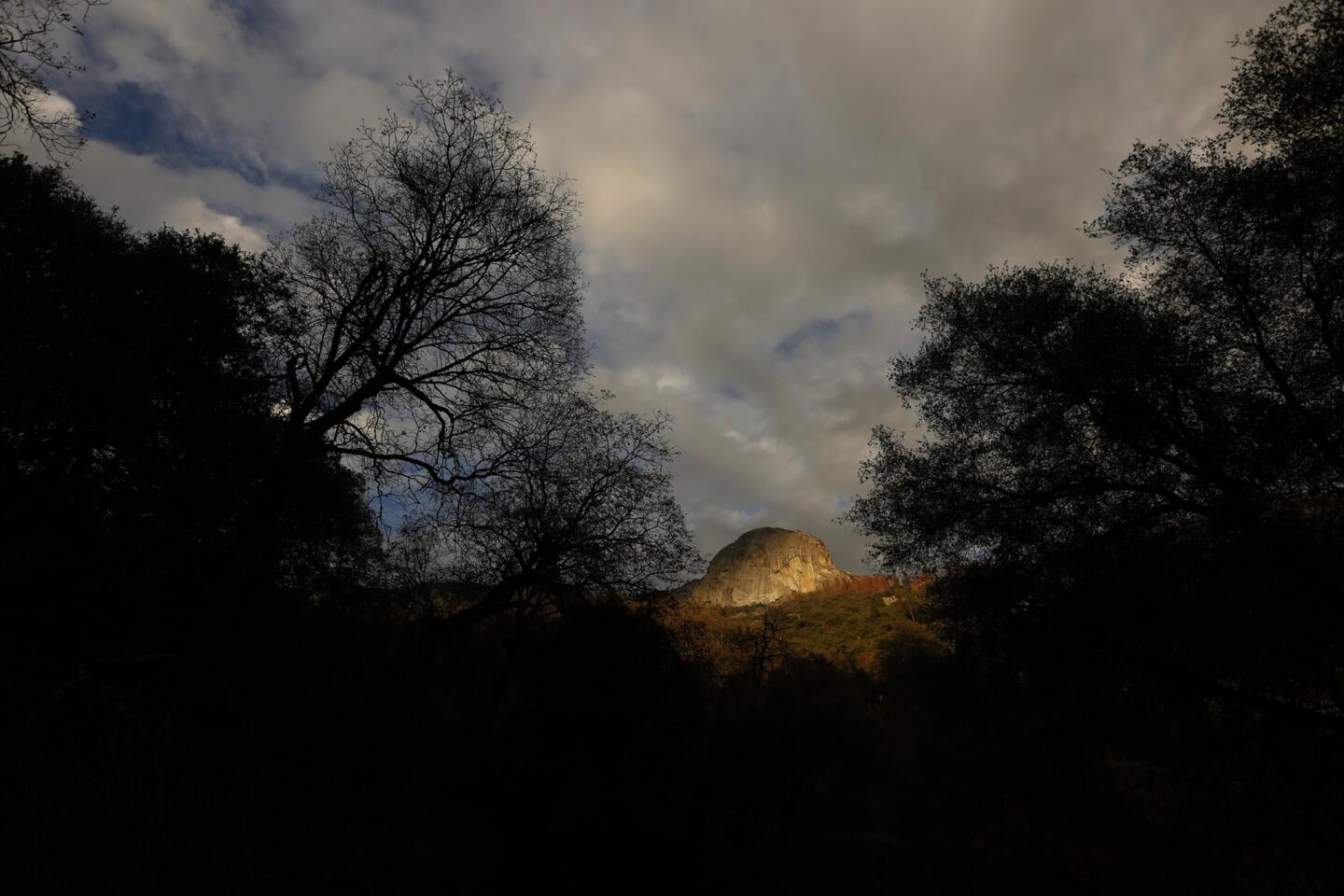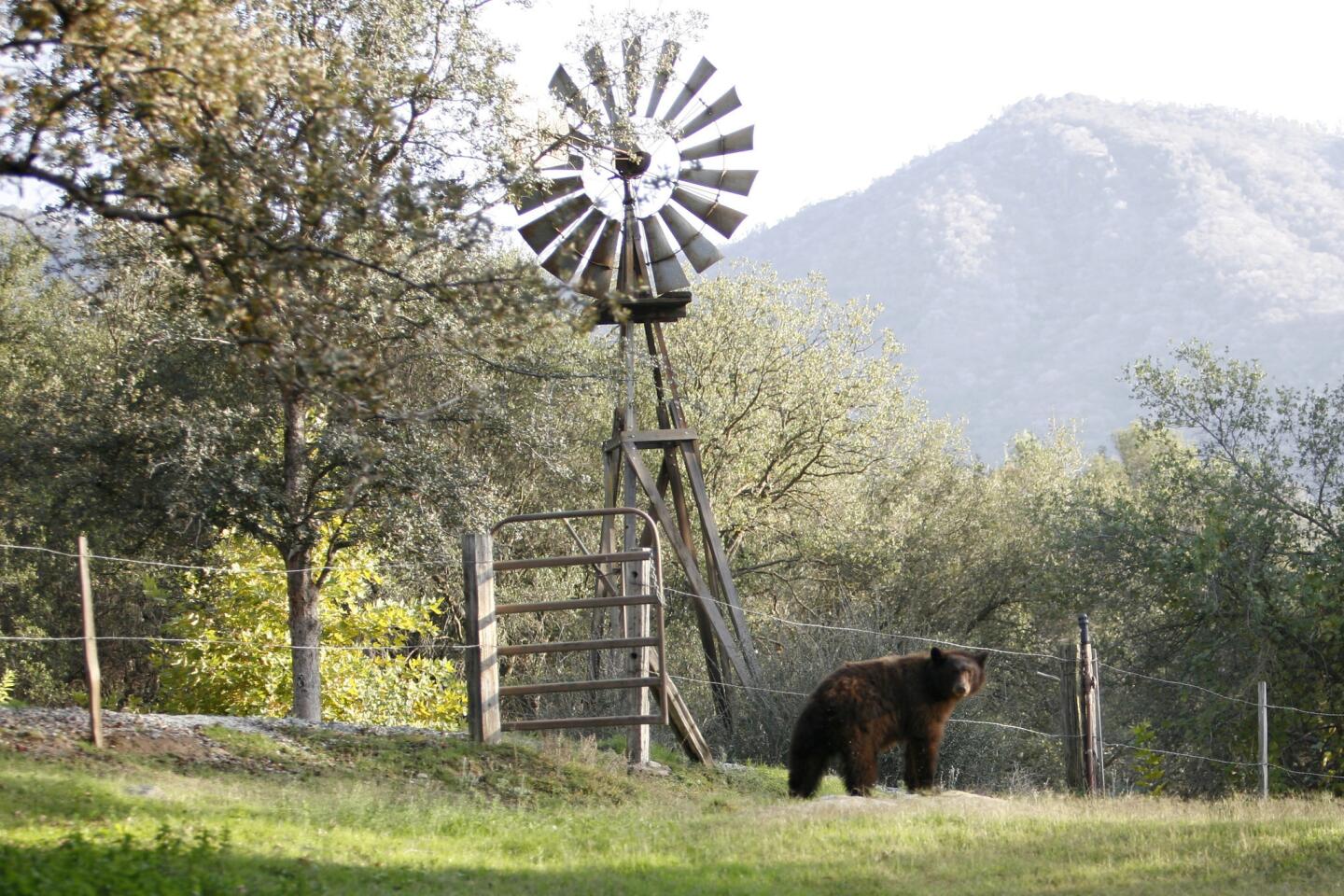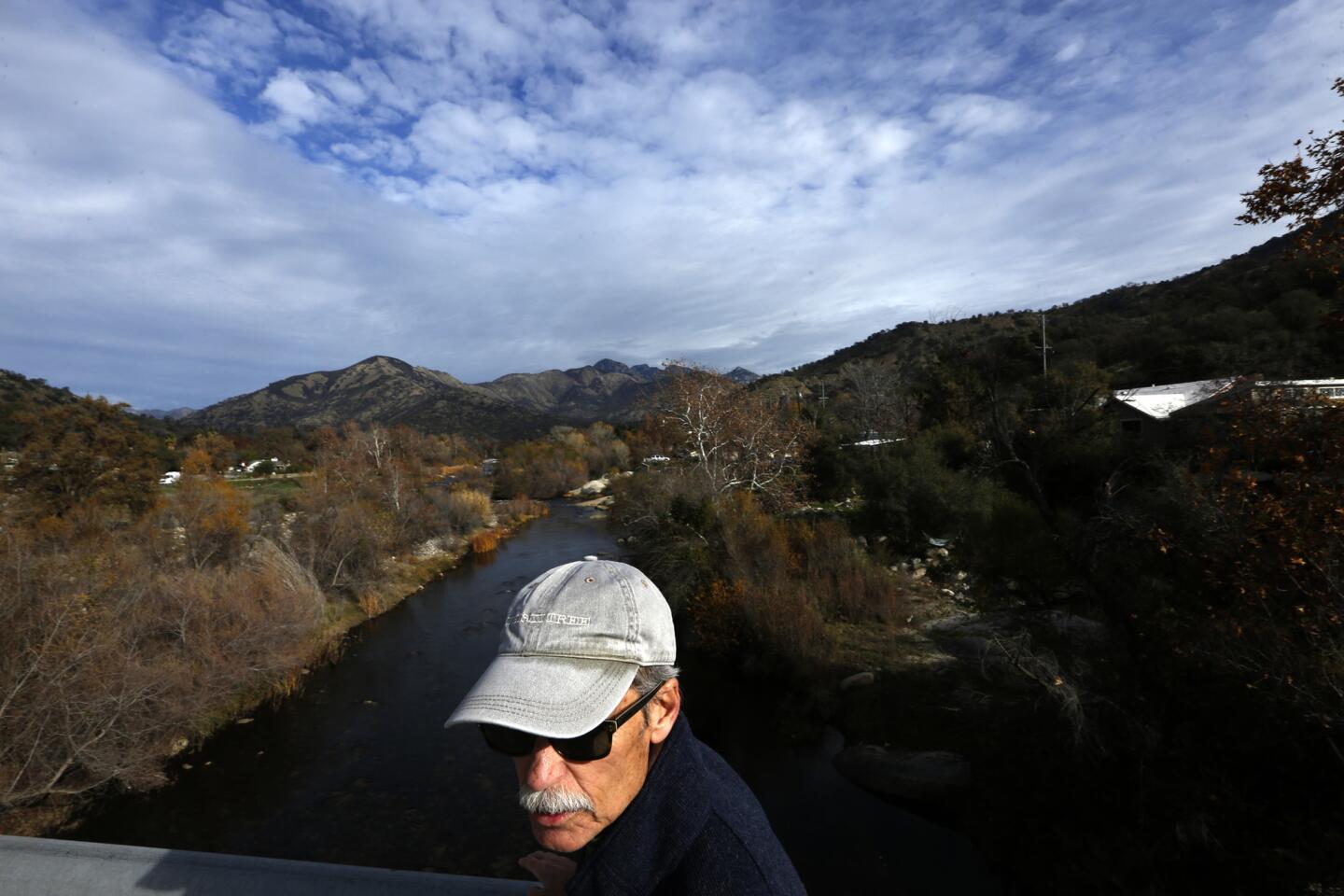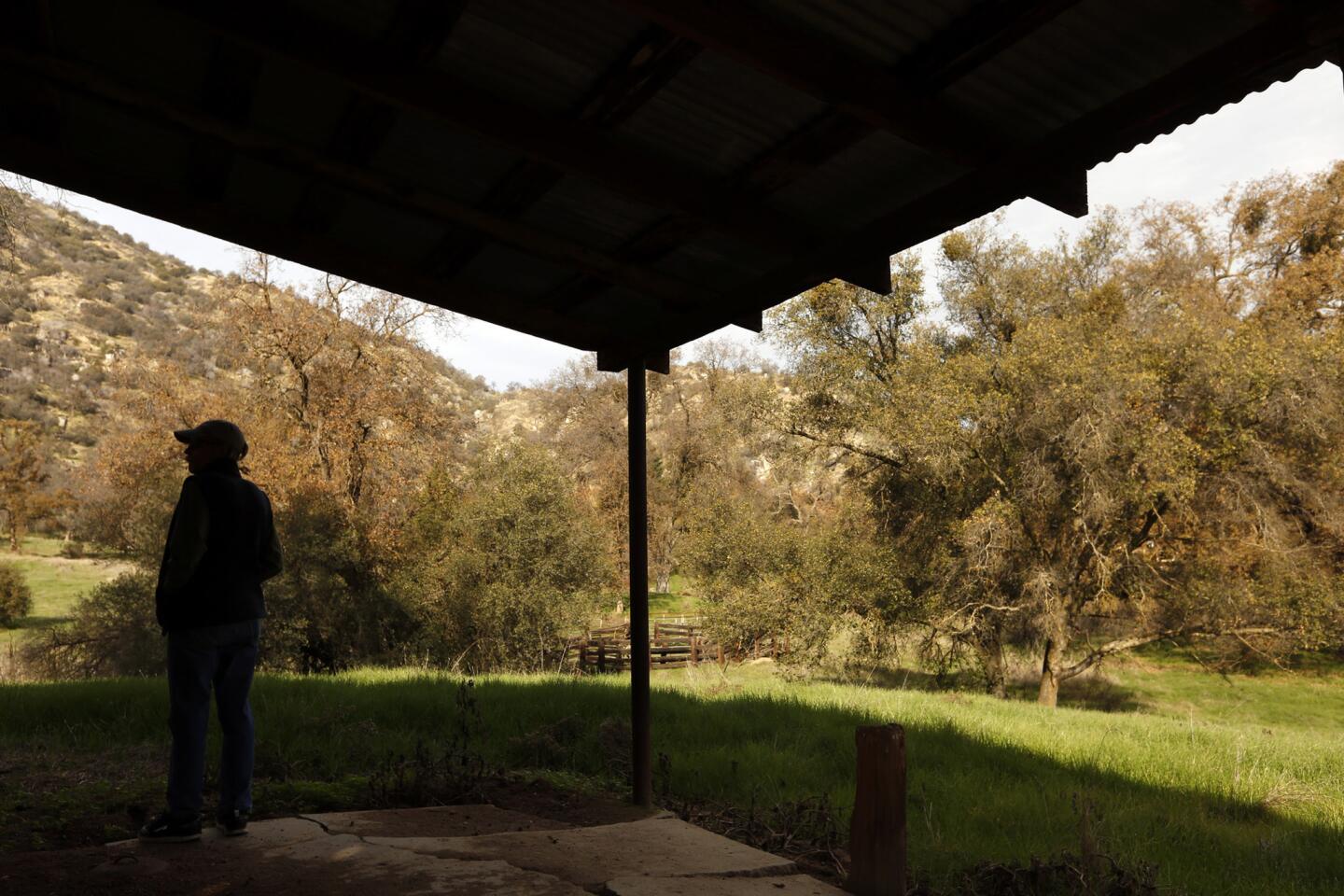A black bear boom has a California town wondering how residents would get along with grizzlies
- Share via
Reporting from THREE RIVERS, Calif. — It was toward the end of the summer last year that the bears came. Families of them. Droves of them. More of them than most residents of this small Tulare County town of 2,500 ever had the pleasure of watching frolic in the Kaweah River — or the frustration of seeing topple trash cans and break into chicken coops.
Last year, though, the bear hoedown ended, leaving people here to wonder where so many of the creatures had gone.
Some who live here on the western edge of Sequoia National Park say that question amounts to an ursine mystery — that unnamed villains illegally killed dozens of these relatively docile black bears.
And that widespread but unsubstantiated allegation has added intensity to an ongoing debate about whether the time is ripe to reintroduce bigger and more aggressive California grizzly bears into the wilds of the Sierra Nevada, including areas in and around Sequoia — a possibility simultaneously under study by UC Santa Barbara geographer Peter Alagona and the Center for Biological Diversity.
What residents in this town call “the great bear influx of 2015” was not without benefits.
Reports of bears peaceably following the scent of food and water around motels, boutiques, coffee shops, bakeries and the local golf course attracted carloads of visitors who spent freely on gasoline, snacks and souvenirs as they sought directions to “bear hot spots” along State Route 198, the main drag through town.

John Elliot continues to argue that unnamed residents and ranchers on the edges of town killed as many as 40 to 50 bears last year without depredation permits.
People went goo-goo over all the bears hanging out at my house.
— Three Rivers resident Greg Dixon
An oak grove in Greg Dixon’s backyard, for example, became an impromptu outdoor theater. Visitors yanked out lawn chairs, cameras and cold beers and watched as many as seven bears at a time lounge on tree limbs, splash in the river and stuff their faces with fallen acorns, spitting out the shells.
“People went goo-goo over all the bears hanging out at my house,” Dixon said. “We all took hundreds of pictures.”
But bears also broke into cabins and vehicles around town, ripped up roof tiles to get at acorns stashed by woodpeckers, threatened livestock and charged people who got too close.
Today, more than 25,000 black bears — with narrow heads and small ears and weighing up to 350 pounds — roam wild in California, state wildlife authorities say.
But there hasn’t been a wild grizzly in California in almost 100 years.
Alaska still brims with brown bears; grizzlies are a subspecies of them. And about 1,600 grizzlies range through isolated high-mountain pockets of Montana, Wyoming and Idaho. But a Los Angeles fruit farmer shot Southern California’s last known grizzly in Big Tujunga Canyon in 1916, and in Northern California, the last credible sighting of the iconic creature that adorns the state flag and a staggering array of merchandise was in 1924.
I have serious doubts about plans to turn grizzly bears loose in this area.
— Jim Barton, former park ranger and current Three Rivers resident
With mammoth shoulders and ears the size of catcher’s mitts, the California grizzly weighed up to 2,000 pounds and prowled foothills and thickets along lowland rivers and creeks. But they were no match for civilized man: Spanish caballeros roped them and then dragged them into public fights with bulls; hunters shot them for sport; ranchers poisoned them to protect livestock.
At least some conservation groups are eager to reestablish grizzly populations in the few remaining places where they once lived and might conceivably live again, controlling deer and elk populations and increasing plant diversity by digging up turf and transporting seeds in their fur and dung.
Living with grizzlies, they acknowledge, would require special precautions.
But the experiences of people living in and around Yellowstone National Park and other areas suggest that with the help of bear spray and other adaptations, “it can be done,” said Noah Greenwald, a spokesman for the Center for Biological Diversity.
Still, there has been persistent pushback against grizzlies in most places where their numbers have grown. In California, too, there are those who think the idea of these massive predators living in proximity to people is a bad one.
“I have serious doubts about plans to turn grizzly bears loose in this area,” said Jim Barton, 92, a longtime resident and former ranger in Yosemite and Yellowstone national parks. “Their lives would end the moment they wandered into town.”
“There isn’t enough room for them, unless you first remove the human occupants,” he said.
It was, experts say, prolonged drought conditions and the fact that their foraging grounds had been devastated by wildfires that drove dozens of desperately hungry bears to seek sustenance in Three Rivers.
By the time the bears left to hibernate during the winter months, passing vehicles had killed at least two and a rancher with a depredation permit had shot and killed another, state wildlife authorities said.
The reason more didn’t return to the town, most experts say, is because they found enough food again in their normal habitat.
But in his weekly newspaper, the Kaweah Commonwealth — and in conversations with anyone who will listen — John Elliott continues to argue that unnamed residents and ranchers on the edges of town killed as many as 40 to 50 bears last year without depredation permits.
The owner, editor and chief writer for the Commonwealth says he is on a mission to save bears by publishing articles based on tips from residents who asked to remain anonymous out of fear of retribution.
“Some people are pretty upset over my articles,” he said. “One guy even pulled an ad from my newspaper that was worth $100 a month. But the killing had to stop.”
That talk rankles California Department of Fish and Wildlife Lt. Doug Barnhart.
“On numerous occasions I’ve told John that we’d be more than happy to go out and nab a poacher,” he said. “But when we asked him for names, phone numbers and facts, the response was silence.”
“The state’s fish and wildlife CalTIP line has not received a single call from someone in Three Rivers wanting to report the illegal killing of a bear or other wildlife,” he said. “Our records show that six depredation permits were issued there in 2015 and of those, I’m aware of one that resulted in a bear being killed.”
Some residents question that assessment.
Mike Hand, business manager at St. Anthony Retreat, where the bears caused an estimated $10,000 in structural damage, insisted that “I know for a fact that five bears were killed last year, all of them with depredation permits.”
Alagona, the UC Santa Barbara researcher, who hopes to publish his study next year, recognizes the challenge of inter-species antagonism.
“Maybe grizzly bears are not appropriate right now,” he said. “Maybe it will take a generation before people think it’s a good idea.”
But, he added, “No one can speak intelligently about reintroducing grizzly bears in Tulare County or anywhere else in California because the last significant study of them was done in 1955.”
In his study, he said, historians, political scientists, legal scholars, anthropologists and others with a variety of perspectives seek to understand the past, present and future of these animals. “Conservation is as much about culture as it is about biology,” he said.
David Graber, a resident of Three Rivers and a former National Park Service biologist who’s worked with bears since 1974, agrees, up to a point.
“I don’t consider black bears to be particularly dangerous,” he said. “I do, however, consider grizzly bears to be dangerous.”
“That’s why people who live among them in places like Alaska peer out of their windows before they step outside, and then proceed with caution,” he said. “Some people use long nails extending out of exterior walls to keep grizzly bears from ripping into their homes.”
“I don’t believe Californians would tolerate a viable grizzly bear population of about 200 animals running around their neighborhoods,” he said. “We don’t have the temperament for it. Those bears would be dead in a few years.”
ALSO
Heavy rain might be a sign of wetter times to come in drought-plagued L.A.
New push to rename L.A. freeway after Barack Obama
Hiking Mt. Baldy? You’ll probably meet ‘Sam,’ a 78-year-old mountaineer
More to Read
Sign up for Essential California
The most important California stories and recommendations in your inbox every morning.
You may occasionally receive promotional content from the Los Angeles Times.
